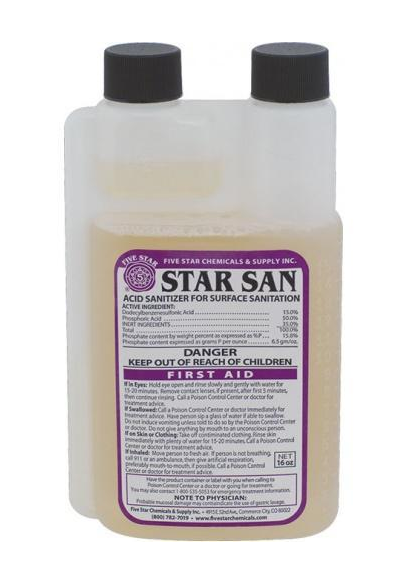When people discuss home-brewed beer, one of their top worries is that it might be dangerous. You may have read or heard horror stories about people who drank tainted homebrew and became deathly sick. You may learn more about whether or not homebrewing beer is risky by reading this article.
Is home-brewed beer risky to drink? Your homemade beer is not inherently unsafe. In contrast to distillation, brewing beer poses few health risks. The worst scenario is receiving a beer that has an off flavor or infection. The biggest health concerns are largely related to improper sanitation and the unintentional use of harmful substances.
There are still some risks that can arise if you don’t handle the beermaking process properly, even if the homemade beer you make won’t harm you any more than regular beer.
Continue reading as I provide some information regarding craft beer facts and potential risks that may arise during production or consumption.
No hazardous bacteria that can thrive in beer have been found, according to the findings.
According to the American Society for Microbiology, beer production and quality can be influenced by a hugely broad range of bacteria. It is difficult to categorically describe the detrimental contributions that the majority of these organisms make because it actually depends on the beer or the function that the organism is meant to perform. The fact remains that there are no known toxicities or risks associated with drinking homebrewed beer.
In the cleaning and handling of equipment, electricity, gas, and other materials when making beer at home, hazards can arise. You handle boiling hot water, kettles, gas, and other things when making beer. These are some of the same dangers you face in your home kitchen when making dinner. So let us not overstate these common risks.
As a dietary concern, most beers contain gluten; you should determine whether or not you can tolerate the gluten in beer before partaking in its glorious nectar.
Making beer makes it impossible for anyone to experience the horrifying stories you hear about people going blind. It turns out that drinking homemade beer wouldn’t harm you because the straightforward fermentation only results in ethanol and not its poisonous relative methanol.
When mishandled, methanol has the potential to be fatal. Home distilling is prohibited in many nations due to the complexity of the process and the potentially fatal risks associated with distilling. Leave distilling to the professionals if you have no training.
Contamination and prevention
Beer contamination is the real “risk” you face. While contamination doesn’t necessarily make you sick after drinking it, it might give it a really unpleasant taste.
Here is a list of indicators that will help you decide if your beer has been infected or developed off flavors.
Horrible odor – trust your nose
This is easy to determine. The beer will smell awful when you open a bottle. Obviously, if it has a foul smell you should toss it out and not take a risk. On top of that, it will most likely be completely unenjoyable even if you try to get over the smell. Is diarrhea or worse worth it? Trust your nose.
The Gusher
When beer is contaminated, it will begin foaming excessively when the bottle is opened, much like when you shake a soda bottle. The frustrating part about this sign is that it won’t be until you serve the beer that you realize it has been tainted. You might end up just having enough for one sip of disappointment. This can also result in bottle bombs (your bottles will literally explode) if too much pressure builds up.
Deterioration over time
As you are surely aware, your beer should taste better as it continues to ferment and condition. However, you should certainly throw out the batch and start over if you sample your beer and discover that it gets progressively worse over time. When beer tastes like wet cardboard, it has likely been exposed to too much oxygen and is therefore polluted or has gone bad. And if your beer taste like a Corona it’s probably skunked due to light hitting the beer. Storing a beer at the right temperature away from the light will help avoid some of the off flavors that develop over time.
Mold
Typically, this takes place when the beer is fermenting. Normally, once a beer has some alcohol content, it will fight off any bacteria that will create mold. You can be certain that your beer has been tainted if you notice even a thin layer of mold on top of your batch while it is still in the fermenter. It’s an even bigger no-go if you see that mold has somehow developed after fermentation. Either way, toss the beer if you see mold of any kind.
Unintentional Sour Beer
Homebrewers can purposely make sour beers like a Gose (Germany’s Goslar is the birthplace of the warm-fermented beer known as “Gose.”). They get these beers sour by purposly infecting their beers with lactobacillus. It results in a pleasantly sour taste when done right. If you have bad sanitation you can get the wrong bacteria that can sour your beer with bad results. It’s like Russian roulette with nature. You might get a good tasting sour or an undrinkable infected disaster.
Trust your instincts and don’t drink the beer if your senses tell you something is off.
The two most important elements of homebrewing are cleaning and sanitization. While it is good to be aware of the symptoms of contaminated beer, the ideal situation is to totally avoid it. It’s unpleasant to ruin a batch of beer that you worked on for several weeks or months. Here are a few suggestions to keep your brewing process easy and clean so you can make sure you do everything you can to prevent it.
There’s no sense in wasting your money and time by not keeping your process clean.
- Cleaning and sanitization: Your equipment needs a good cleaning. Make it a routine to always thoroughly clean your equipment before and after using it. It is crucial to clean it well, especially after usage, because leftover batch residue can get rather sticky and make cleaning it for use the next time challenging. The bottles you use to pour the beer into should also be rinsed afterward to get rid of any residue that might have built up on the bottom or sides. Additionally, it’s a good idea to keep the overall area where you store or use your equipment tidy. This is needed to help avoid letting undesirable germs into your batch. It cannot be emphasized enough how crucial it is to sanitize your tools. As was previously said, mold and bacterial illnesses can ruin your batch. Therefore, before mixing your batch, make sure that the equipment is cleaned.

- Protect the yeast! Use sanitized equipment when handling yeast. Dry yeast, in particular, is more susceptible to contamination when added to wort. Ensure that anything you use to open the yeast packet is sterile and clean. You should even sanitize the packet of yeast and the scissors used to open it.
- Get the fermentation going: As soon as you can, begin the fermentation process. As soon as you can, pitch the yeast into the wort. That helps the yeast take hold before the bacteria have a chance to grow and overtake the yeast propagation, as the wort is highly susceptible to bacteria or other germs. As a general rule, you should notice some fermentation activity in about 24 hours.
- Stay cool: Keep your fermenting beer in a cool, dark place. Homebrewers should be aware of this, so be sure to store your fermenting batch in a cool, dark location because light might skunk it. This applies to beer in bottles as well. Light and warm temperatures might ruin your beer in the fermentation and storing stage.
To maintain the quality of your homebrewed beer, keep it clean and adhere to these suggestions.
Therefore, the basic response to the question of whether homebrew will kill you is “NO.” While the process of making your batch can be hazardous if you are careless, the beer itself cannot become toxic. You can become ill if you drink an infected beer, but it should be pretty clear that the beer is undrinkable by its smell and/or its appearance.
The only true “risk” is making lousy beer and losing your batch and your investment, but if you use the advice above, you can virtually guarantee that contamination won’t occur.
Heavy beer intake, whether it be homebrewed or purchased, can result in alcohol toxicity, which in the worst situations can be fatal. The CDC advises against exceeding the daily limits of one drink for women and two for men. Naturally, this also applies to homebrewed beer, so use caution when drinking. Go to the NIAAA Navigator for help.
youhadmeatbeer.com, 2022 (c) All rights reserved. Without previous written consent from youhadmeatbeer.com, no part of this publication may be duplicated or communicated in any way, whether it be electronically, mechanically, photocopying, recording, or otherwise.

